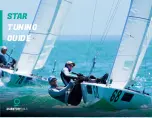
31
Wash the bottom of the boat immediately after the boat has been lifted. Algae and slime will come off easi
-
er if they are not left to dry.
Give the engine and other equipment their winter servicing, following their separate manuals. If your boat
is stored outside or in a humid place over the winter, empty it of textiles and other equipment that may
corrode or become mouldy in damp conditions. Wash the ropes in fresh water. Replace any worn ropes.
Leave through fitting valves open. Remove the drain plug for the winter.
Electronic instruments are best protected against oxidation and theft by detaching them and removing
them to a dry indoor environment for the winter. Detach the batteries and store them in a warm, dry place.
Charge the batteries at least twice during the winter. Spray the couplings of the electrical system with an
appropriate water repellent antioxidant.
Always cover your boat so that water or snow cannot gather inside. Always make sure, however, that it is
adequately ventilated. A winter storage cover is available as an optional accessory for your boat.
NOTE!
Make sure that the winter storage cover or its ropes do not touch the aluminium
hull. If the cover or its ropes abrade the hull, they will leave black marks on it.
12.2.
Measures before launching the boat
Repair any damage to the gelcoat surface according to section 6.9.
In sea areas, antifouling paint should be used to prevent the hull from becoming covered with vegetation.
Fouling of the bottom and especially the propeller increases fuel consumption significantly. However, if the
boat is anchored at the inlet of a stream or in the Bothnian Bay, or if it is lifted out of the water at least once
every two weeks, it is normally not necessary to use antifouling paint. Carefully follow the paint manufac
-
turer’s instructions when applying the paint. When sanding old antifouling paint, remember that the dust is
toxic. Antifouling paint is not necessary in fresh water (lake areas).
NOTE!
Do not apply any paint to the zinc anodes, depth finder sensor, or piston rods
of the hydraulic trim tabs. Do not apply paints containing copper or lead on al
-
uminium parts. Remember to follow the paint manufacturer’s instructions. The
warranty does not cover damage caused to the hull by antifouling paint contain
-
ing lead or copper.
Useful tip:
Do not throw away a used paint brush. A dried-up antifouling paintbrush can be
rejuvenated by soaking it for a couple of hours in a mixture of 2 l hot water, 1 dl
vinegar and 0.5 dl baking powder.
Perform the necessary service procedures required for the engine according to the engine manual. Check
the functioning of electric equipment and remove any oxidation from fuse connectors etc.
Remember that petrol goes stale over time, and you must always start the engine with fresh petrol in the
spring.
When the boat has been launched you should open all valves in the through fittings (bushings) and check to
ensure that there are no leaking hoses or connectors. The locations of through fittings are shown in section
5. Bring your safety equipment back on board before setting out.
13.
Lay-out
13.1.
General lay-out
Summary of Contents for 75
Page 1: ...Yamarin Cross 75 Bow Rider Käyttäjän käsikirja Användarhandbok Owner s manual ...
Page 2: ...2 Yamarin Cross 75 Bow Rider Owner s manual ...
Page 5: ...5 ...
Page 41: ...41 ...
Page 42: ...42 Yamarin Cross 75 Bow Rider Käyttäjän käsikirja ...
Page 45: ...45 ...
Page 80: ...80 8 0 ...
Page 81: ...81 ...
Page 82: ...82 Yamarin Cross 75 Bow rider Användarhandbok ...
Page 85: ...85 ...













































